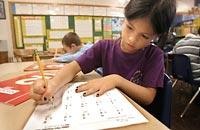Making math instruction add up

Many people are upset about mathematics these days. Nearly 50 percent of Washington's 10th-graders didn't meet the state's mathematics standards. Parents are protesting "standards-based" teaching materials. Some claim that the mathematics standards aren't mathematical enough.
Where did the mathematics standards come from? Washington state's mathematics standards were written, in part, because area employers couldn't find skilled workers in the local employment pool. This is a nationwide problem. The U.S. is one of the few countries in the world where it is acceptable to say, "I don't do math."
In response to these issues, Washington's 1993 school reform law mandated "world class" standards that all students would attain "on or about the age of 16."
The problem with mathematics isn't with the standards. There's plenty of good old-fashioned mathematics in our standards. What's important about Washington's standards is that all students are to learn how to do mathematics.
What's controversial about our standards is that students are to understand the mathematics they do and know how to use mathematics in the world beyond school. It's hard to argue with these goals.
The real problem with mathematics is how it is taught. Across the country, the daily routine is something like this: Students are introduced to a mathematical procedure; they do 20 to 40 exercises to practice the procedure; the next day they go over their homework; at the end of a week or so, they take a test over the procedures presented since the last test.
Little effort is made to connect the procedures or to show students how the procedures are used in real situations. In addition, as students move through the grades, mathematics becomes more abstract — making it harder for students to make sense of it on their own.
As I finished my latest Sudoku book, I realized why some of us didn't mind the way mathematics was taught in school. For some, mathematics exercises were fun puzzles to solve. We enjoyed solving a system of equations, factoring polynomials, and writing equations for geometric transformations. For some, learning mathematical procedures was just part of being a good student. We — the puzzle thinkers and the good students — probably noticed that the number of students taking mathematics courses got smaller as mathematics became more abstract. But that was OK.
When I went to college, I was discouraged from taking mathematics courses because I was a girl. It wasn't until I took a theoretical mathematics course in graduate school that I learned how the procedures I enjoyed in high school were used to build mathematical models. What an eye opener!
There are two problems with this scenario. First, very few people become theoretical mathematicians; few discover the purpose of abstract mathematics. Second, memorizing dozens of abstract procedures doesn't help students understand how to use mathematics to solve theoretical or everyday mathematical problems.
For example, systems of equations can be used to decide which of two investments will yield the best profits or under what conditions two investment options will result in the same profit; geometric transformations can be used to create video games and graphic designs; statistics can be used to describe or predict changes in weather, population, air pollution, consumer confidence, etc.
Computers may do computations for us, but programmers with strong mathematical skills write the programs. Professionals may help us make business decisions or prepare statistical information, but people with strong mathematical skills make sense of the data presented by professionals.
The state's standards mandate that students learn how to use mathematics to solve problems; to read, interpret, and represent mathematical information; to think mathematically; and to apply mathematics in the world beyond school. If we are to accomplish these goals, math must be taught in a way that enables all students to understand higher levels of mathematics and to use mathematics knowledgeably in their lives.
Over the past few years, we have seen tremendous progress in Washington's education system. As schools adopt standards-based teaching materials, more and more students are achieving in mathematics.
Rather than give up on the standards and return to ways that lock out so many, we should demand that all mathematics teachers teach all students the what, how and why of mathematics.
If we retreat from our standards now, we will return to a system that creates barriers to high-paying jobs in business, medicine, science and technology. By staying the course, we will see more students develop the knowledge and skills needed to be successful in school and to be knowledgeable employees, entrepreneurs and citizens of tomorrow.
Catherine S. Taylor is an associate professor of education at the University of Washington. Taylor serves on Washington state's National Technical Advisory Committee for Assessment and was a member of the committee that designed the Washington Assessment of Student Learning math test.
